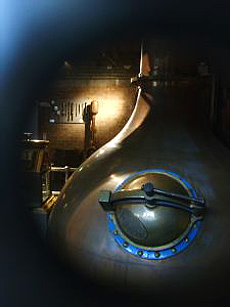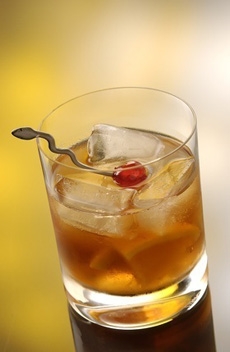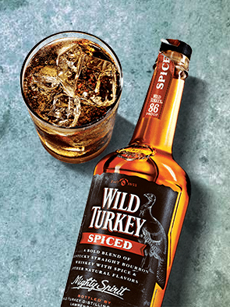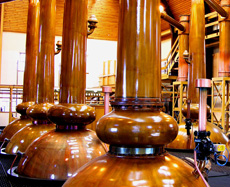
 A whiskey still, dramatically lit. Photo by Dora Pete | SXC.
A whiskey still, dramatically lit. Photo by Dora Pete | SXC.
March 2006
Last Updated July 2025
|
 |
Product Reviews / Main Nibbles / Cocktails & Spirits
Whiskey Glossary
Terms, Definitions For Bourbon, Scotch, Irish Whiskey & More
Page 1: Terms Starting With A-B
This glossary is a companion piece to our overview article about whiskey, Whiskey 101. Please contact us if you’d like to suggest additional terms. The Whiskey Glossary is just one of many food glossaries. Take a look at the entire collection.
> The different types of rum.
> The different types of tequila.
Click on a letter to go to the appropriate glossary section:
a b c d e f g h i j k l m n o p q r s t u v w x y z
This glossary is protected by copyright and cannot be reproduced in whole or in part without written permission. You are welcome to link to it.
AMERICAN WHISKEY
Bourbon and Tennessee Whiskey are distinguished in flavor from other types of whiskey, largely because the grain mash used to make them contains more than 50 percent corn. The home-brewed versions—“moonshine” and “hooch”—follow a similar formula and therefore share a similar taste, although they lack the refinement from aging. All American whiskeys except corn whiskey must be aged in new casks that have been charred on their inside surface. See the individual entries for Bourbon, Corn Whiskey, Hooch, Moonshine, Tennessee Whiskey, and Rye.
AQUA VITAE
Latin for “water of life,” the original name given to whiskey by the Irish monks who created it in the sixth century C.E.
BLENDED GRAIN
Denotes a mixture of grain whiskies (no malt) from different distilleries.
BLENDED MALT
A mixture of malts (no grain) from different distilleries.
BLENDED WHISKEY
A product composed of both straight whiskey and neutral spirits. The blend typically comes from a number of distilleries so that the blender can produce a consistent flavor; the bottle contains only the brand name (Dewars and Chivas Regal are blended Scotches, Tullamore Dew is a blended Irish whiskey, e.g.) and not the name of a distillery. Generally, the taste of blended whiskey is more mellow than both the straight and single malt whiskeys. Like straight whiskey, blended whiskey must be at least 80 proof. Prior to a change in law in the latter half of the 19th century, malt and grain whiskies were produced separately; the law allowed malt and grain to be combined.
|
|

Blended whiskey in a whiskey sour (photo © Lognetic | Fotolia). |
BLENDING
Mixing malt or pot still whiskey with grain whiskey.
BOURBON
A whiskey made with at least 51% maize (corn) and/or rye, distilled twice in a continuous still. It was first made in Bourbon County, Kentucky, in 1789 by a Scotsman, and was called “American Scottish Whiskey” until the U.S. government officially adopted the name Bourbon in 1963. There are three styles of Bourbon: Kentucky Bourbon (e.g., Jim Beam, Maker’s Mark); Tennessee Whiskey (e.g., Jack Daniel’s), which is not technically a Bourbon since it is made in Tennessee, but is often referred to as Bourbon; and Rye, which uses rye instead of corn as an ingredient. Each has distinct flavors based on the grains and the time matured in oak. The main difference between Bourbon and Tennessee Whiskey is that the latter develops a sweetness as it is slowly filtered through large vats of sugar-maple charcoal.
|
|

New and exciting: spiced Bourbon. Photo courtesy Wild Turkey. |
In the specialty Bourbon area, there are small-batch Bourbons, more complex and sophisticated; wheated Bourbons, distilled from wheat and barley malt in addition to the mandated minimum of 51% corn; and, following in the footprints of Scotch, there now are fine Bourbons aged for 10, 15, and 20 years. Here’s more information on how to drink bourbon.
|
BREWING
The process of producing alcoholic liquids, which is aided by yeast from the sugars present in a solution of fermented grains.
BROWN GOODS
In the world of spirits, “brown goods” refers to aged spirits that have a characteristic brown or amber color due to their time spent aging in wooden barrels. In addition to color, barrel aging imparts complex flavors and aromas. Brown goods include Bourbon, brandy/Cognac, rye, and Scotch.
|
|

Whiskey stills at the Glenmorangie Distillery in Tain, Scotland. Photo by Bern Altman | SXC.
|
Continue To Page 2: Terms Starting With C-F
Go To The Article Index Above
© Copyright 2005- Lifestyle Direct, Inc. All rights reserved. Images are the copyright of their respective owners.

|







